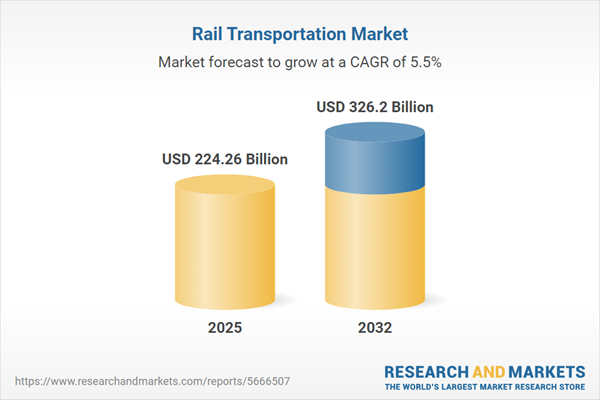Speak directly to the analyst to clarify any post sales queries you may have.
The rail transportation market is undergoing a phase of rapid transformation, balancing technological progress with evolving regulatory and sustainability demands. Senior decision-makers must adapt strategies to leverage new competitive advantages, manage operational risks, and respond to shifting global trade dynamics.
Market Snapshot: Rail Transportation Market Size and Growth Potential
The Rail Transportation Market grew from USD 212.42 billion in 2024 to USD 224.26 billion in 2025. It is expected to continue growing at a CAGR of 5.50%, reaching USD 326.20 billion by 2032. Robust expansion is driven by ongoing infrastructure modernization, technological advancements, and intensifying sustainability efforts across freight and passenger segments.
Scope & Segmentation
This comprehensive report analyzes the global rail transportation industry, assessing diverse business models, regional dynamics, and emerging technology integrations. The research covers the full value chain, including service providers, manufacturers, and key stakeholders. Market segmentation includes:
- Service Types: Freight, including bulk (coal, grain, ore), containerized, intermodal, mixed. Passenger, including commuter (off-peak, peak), high-speed, light rail, metro, regional.
- Cargo Types: Automobiles, bulk, containerized goods, hazardous materials, refrigerated products.
- Rolling Stock: Locomotives (diesel, electric, hybrid), wagons (boxcar, flatbed, hopper, tank).
- Geographical Regions: Americas (United States, Canada, Mexico, Brazil, Argentina, Chile, Colombia, Peru), Europe, Middle East & Africa (United Kingdom, Germany, France, Russia, Italy, Spain, Netherlands, Sweden, Poland, Switzerland, United Arab Emirates, Saudi Arabia, Qatar, Turkey, Israel, South Africa, Nigeria, Egypt, Kenya), Asia-Pacific (China, India, Japan, Australia, South Korea, Indonesia, Thailand, Malaysia, Singapore, Taiwan).
- Key Companies: Alstom S.A., BNSF Railway Company, Canadian National Railway Company, Canadian Pacific Kansas City Limited, Caterpillar Inc., Central Japan Railway Company, China Railway Group Limited, CSX Corporation, DB Cargo AG, DHL International GmbH, Hallcon Corporation, Hitachi Ltd., Kintetsu Railway Co., Ltd., Motive Power Ltd., MTR Corporation Limited, Nagoya Railroad Co., Ltd., Norfolk Southern Corporation, OmniTRAX, Inc., Patriot Rail Company LLC, Professional Transportation, Inc., R. J. Corman Railroad Group, Russian Railways, Thales Group, Union Pacific Railroad Company, Wabtec Corporation, Watco Companies, L.L.C.
Key Takeaways for Senior Leaders
- Digitalization is central, with rail operators prioritizing predictive analytics, IoT, and digital twin integration to optimize performance and asset management.
- Sustainability mandates are accelerating investment in electrification, fuel alternatives, and network upgrades to meet stakeholder and regulatory expectations.
- Collaborative ventures between public and private actors are reshaping procurement and fast-tracking technology adoption, increasing operational agility.
- Freight and passenger service providers face shifting customer expectations and regulatory challenges, driving product and service innovation.
- Acquisitions and strategic alliances are enabling value chain integration, supporting diversification and scalable market entry, especially in growth regions.
Evaluating Tariff Impact on Supply Chain and Operations
The United States’ 2025 tariffs on critical materials such as steel and aluminum are pressuring rail industry margins and supply chain strategies. Operators are reassessing supplier portfolios, favoring regional partnerships and localizing value chains to ensure continuity and competitive procurement. This shift also prompts capital reallocation to advanced manufacturing and modular design, supporting domestic production and mitigating input cost volatility. Joint ventures and co-development partnerships are gaining prominence as firms navigate evolving tariff scenarios.
Methodology & Data Sources
This report utilizes primary interviews with industry experts, regulatory figures, and technology leaders, complemented by structured surveys. Secondary sources include industry publications, government data, technology whitepapers, and proprietary datasets. Analytical approaches such as scenario mapping and trend extrapolation ensure robust, actionable insights for executives and investors.
Why This Report Matters
- Enables leaders to anticipate regulatory and technological shifts and align business models accordingly.
- Supports risk mitigation and investment planning by delivering clarity on regional developments and supply chain resilience.
- Guides strategic collaboration decisions across freight, passenger, and technology segments to drive sustainable growth.
Conclusion
Senior decision-makers equipped with this report can confidently refine market strategies, develop resilient operations, and remain agile amid global change. Informed insights empower you to leverage opportunities and future-proof your position within the evolving rail transportation market.
Additional Product Information:
- Purchase of this report includes 1 year online access with quarterly updates.
- This report can be updated on request. Please contact our Customer Experience team using the Ask a Question widget on our website.
Table of Contents
3. Executive Summary
4. Market Overview
7. Cumulative Impact of Artificial Intelligence 2025
Companies Mentioned
The companies profiled in this Rail Transportation market report include:- Alstom S.A.
- BNSF Railway Company
- Canadian National Railway Company
- Canadian Pacific Kansas City Limited
- Caterpillar Inc.
- Central Japan Railway Company
- China Railway Group Limited
- CSX Corporation
- DB Cargo AG
- DHL International GmbH
- Hallcon Corporation
- Hitachi Ltd.
- Kintetsu Railway Co., Ltd.
- Motive Power Ltd.
- MTR Corporation Limited
- Nagoya Railroad Co., Ltd.
- Norfolk Southern Corporation
- OmniTRAX, Inc.
- Patriot Rail Company LLC
- Professional Transportation, Inc.
- R. J. Corman Railroad Group
- Russian Railways
- Thales Group
- Union Pacific Railroad Company
- Wabtec Corporation
- Watco Companies, L.L.C.
Table Information
| Report Attribute | Details |
|---|---|
| No. of Pages | 194 |
| Published | November 2025 |
| Forecast Period | 2025 - 2032 |
| Estimated Market Value ( USD | $ 224.26 Billion |
| Forecasted Market Value ( USD | $ 326.2 Billion |
| Compound Annual Growth Rate | 5.5% |
| Regions Covered | Global |
| No. of Companies Mentioned | 27 |









